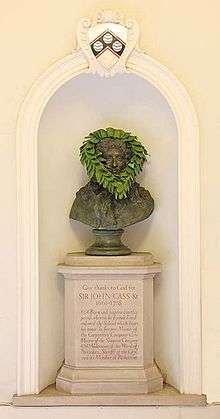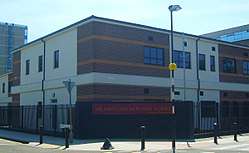John Cass
Sir John Cass (February 1661[lower-alpha 1] – 5 July 1718) was an English merchant, Tory member of parliament, philanthropist and a major figure in the early development of the Atlantic slave trade.[1]

Biography
Early life
He was born in Rosemary Lane, in the City of London, son of Thomas Cass, carpenter to the Royal Ordnance. He was baptised on 28 February 1660 at St Botolph's Aldgate. In 1665, the family moved to Grove Street, in South Hackney to escape the plague.[2]
On 7 January 1684 he married Elizabeth Franklin.
Professional career
Cass was a merchant, builder and politician.
In 1705 Cass became a member of the court of assistants (equivalent to the board of directors) of the Royal African Company[3] which had held the monopoly in England on trading along the west coast of Africa in gold, silver, ivory and slaves from 1662.[4] This company had been set up by King Charles II and his brother the Duke of York (later King James II), who was the governor of the company, together with City of London merchants.[5][6] The slaves were sold for labour on tobacco, and, increasingly, sugar plantations.[7] He still held shares in the Royal African Company on his death.
Cass was elected as one of the Tory MPs for the City in 1710. He was re-elected in 1713 but lost to the Whig faction in 1715.[3] He served as alderman, for the ward of Portsoken from January 1711 and in June 1711 was elected as one of the sheriffs of London. As sheriff, he was knighted in June 1712.[8]
He was appointed a commissioner of the Commission for Building Fifty New Churches, in 1711; this was a scheme to provide new churches for the rapidly expanding population of the metropolis.[9]
Cass was Master of the Worshipful Company of Carpenters in 1711–12, concurrent with his shrievalty;[10] but in 1714 he transferred to the Skinners' Company, and became their Master.
Between 1709 and 1715 he was treasurer to the Bridewell and Bethlehem Hospitals.[2]
Slavery
Cass was "a major figure in the early development of the slave trade and the Atlantic slave economy, directly dealing with slave agents in the African forts and in the Caribbean" according to a BBC report following the Black Lives Matter demonstrations.[1][11][12][13]
Death
He died on 5 July 1718, aged 57 of a brain haemorrhage and was buried in the churchyard of St Mary Matfelon, in Whitechapel, now the Altab Ali Park. His widow Elizabeth née Franklin died on 7 July 1732.[14] They had no children.
Legacy
Slave Trader
He was also a philanthropist who founded a school for fifty boys and forty girls in buildings in the churchyard of St Botolph's Aldgate in 1709. Cass had made a will at this time, but when his health failed in 1718, he planned to make a new version taking account of the extra property he had acquired in the intervening years. Cass began a new will, but by the time of his death only two pages had been initialled.[15] The will – worth £2,000 – was contested by his heirs at law in the Court of Chancery. Lady Cass continued as patroness of the schools, but died in 1732. The school continued for a few more years under the aegis of Valentine Brewis, one of the trustees Cass had named, but was closed down after his death in 1738. In the early 1740s the remaining trustees petitioned Parliament for the permanent endowment of the school, and the will was finally upheld thirty years after Cass's death.[16] This enabled the Sir John Cass's Foundation to be established in 1748.[17]
Sir John Cass's Foundation

His charity continued to fund the Sir John Cass Foundation School as well as providing for the establishment of the Sir John Cass Technical Institute, which was founded in 1899 and moved into newly built premises at 31 Jewry Street, London, in 1902; becoming Sir John Cass College in 1950. In 1965, the college's Department of Fine and Applied art merged with the Department of Silversmithing and Allied Crafts from the Central School of Art to form the Sir John Cass School of Art, which moved into its own new premises at Central House, opposite the Whitechapel Art Gallery. The Sir John Cass College merged with the City of London College in 1970 to form the City of London Polytechnic; becoming London Guildhall University and merging to form the London Metropolitan University in 2002.[18]
The modern foundation provides support to a primary school within the City – near to St Botolph's, (Sir John Cass's Foundation Primary School); a secondary school (Sir John Cass Redcoat School) in the London Borough of Tower Hamlets; the Sir John Cass Faculty of Art, Architecture and Design within London Metropolitan University; and the Cass Business School within City, University of London.
The foundation has provided funding for the Sir John Cass School of Education at the University of East London campus in Stratford, London. Funding has also been provided for the Sir John Cass Hall, a hall of residence for students, in Well Street, London Borough of Hackney.
On 10 June 2020, Professor Lynn Dobbs, Vice-Chancellor of London Metropolitan University announced that the name of Cass would be removed from their Art, Architecture and Design School. This followed the toppling of the statue of Edward Colston, a fellow slave trader, in Bristol a few days earlier and the international protests and movement to review historical associations with the slave trade in the wake of the killing of George Floyd in Minneapolis in May 2020. The Sir John Cass Redcoat School announced the school would be changing its name to remove the reference to Cass due to his connections with the slave trade.[19] In July 2020, City, University of London announced that the name of its business school would be stripped of its association with Cass.[20]
The foundation has committed to change its name.[21]
Memorials
- The statue of John Cass is a 1751 lead figure designed by Louis-François Roubiliac. Cass is shown wearing a long wig and the sheriff's gown. The original statue now stands in the Guildhall in London, and a number of copies stand in various places including outside the Sir John Cass School, at Duke's Place and Mitre Street.
- Cassland Road in Hackney commemorates the landholdings of the Cass family, in the district
- A row of almshouses (founded by William Monger) in 1669, were subsequently funded by land owned by Cass on Hackney Marshes. In 1849, they were rebuilt by Sir John Cass's Foundation.[22]
- A statute of Cass was on the facade of the Sir John Cass Foundation building in Jewry Street, in the City of London. It was removed in early July 2020.
- At the University of East London, in Newham, the Education and Early years department is known as the Cass School of Learning. In the Atrium of the Cass building once stood a statue of Sir John Cass which was removed during the George Floyd protests on 11 June 2020. A statement from the university reads as such "We have removed the statue of Sir John Cass from the school of education and communities and we will be instigating a university wide review of all sources of historical funding along with developing a new institutional naming policy that reflects our values of equality, diversity and inclusion."
- A memorial bust in St Botolph's Aldgate was removed on 20 June 2020.[23][24]
Notes
- Baptism 28 February 1661
References
- "London slavery statue removed from outside museum". BBC News. 9 June 2020.
- Sir John Cass, Statue, Sir John Cass School, Duke's Place / Mitre St Archived 1 August 2011 at the Wayback Machine (Public Monument and Sculpture Association) accessed 29 May 2009
- "CASS, John (1661-1718), Grove Street, Hackney, Mdx. History of Parliament Online". www.historyofparliamentonline.org. Retrieved 8 July 2020.
- Morgan, Kenneth (September 2004). "Colston, Edward". Oxford Dictionary of National Biography. Oxford University Press. doi:10.1093/ref:odnb/5996. Retrieved 14 August 2010. (subscription or UK public library membership required)
- "Britain's involvement with New World slavery and the transatlantic slave trade". The British Library. Retrieved 18 October 2018.
- Matthew, Parker (2011). The sugar barons: family, corruption, empire, and war in the West Indies. New York: Walker & Co. p. 126. ISBN 9780802717443. OCLC 682894539.
- "Slavery in the Caribbean – International Slavery Museum, Liverpool museums". liverpoolmuseums.org.uk. Retrieved 19 November 2018.
- "No. 5018". The London Gazette. 14 June 1712. p. 1.
- List of commissioners and officers, The Commissions for building fifty new churches: The minute books, 1711–27, a calendar (1986), pp. XXXIV-XXXVII. Date. Retrieved 27 May 2009
- Court Minute Books of the Carpenters' Company, Guildhall Library, London, MS. 4329/15, sub anno.
- Dresser, Madge (1 October 2007). "Set in Stone? Statues and Slavery in London". History Workshop Journal. 64 (1): 162–199. doi:10.1093/hwj/dbm032 – via academic.oup.com.
- "Hackney, Sugar and Slavery" (PDF). lrgr14.files.wordpress.com. Retrieved 20 June 2020.
- Britain's History and Memory of Transatlantic Slavery: Local Nuances of a 'National Sin'; Donington, K. et al, 2016, Oxford University Press, pp 181-2
-

- https://api.parliament.uk/historic-hansard/commons/1895/mar/18/sir-john-casss-charity
- Chancery Proceedings C11/991/10 9 December 1722
- Shutters Court – Sir John Fouches, A Dictionary of London (1918). Date. Retrieved 27 May 2009
- "Sir John Cass College". AIM25. Retrieved 27 May 2009.
- King, Jon. "Sir John Cass's Foundation and Redcoat school in Stepney Green to change its name over slave trader link". East London Advertiser. Retrieved 27 June 2020.
- "City, University of London's Business School will no longer be known as Cass". City, University of London. 6 July 2020. Retrieved 6 July 2020.
- "Our Commitment to a change of name". Sir John Cass Foundation. Retrieved 7 July 2020.
- Hackney: Charities for the Poor, A History of the County of Middlesex: Volume 10: Hackney (1995), pp. 166–172. Date. Retrieved 28 May 2009
- This morning we removed the bust of John Cass
- Brooke, Mike. "Now St Botolph's Church in Aldgate removes bust of John Cass following George Floyd killing in US". East London Advertiser. Retrieved 20 June 2020.
External links
| Wikimedia Commons has media related to John Cass. |